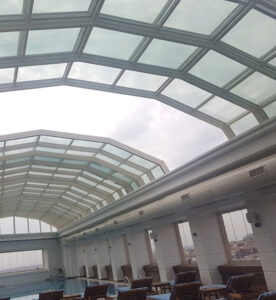Retractable Roof System
High-quality materials like aluminum and tempered glass typically increase the price but ensure durability and low maintenance. Premium finishes and UV-resistant coatings may also add to the cost. These are also known as sliding glass systems.
Why Choose a Retractable Roof?
- Flexible comfort: enjoy the breeze in the morning and close up for midday sun or a quick shower.
- Bigger usable hours: turn hot or windy zones into spaces you can use most of the day, most of the year.
- Neat appearance: slim profiles, hidden fasteners, and matching RAL colours keep the design modern.
- Low maintenance: powder-coated aluminium won’t warp, swell, or rot in heat and humidity.
- Upgrade-ready: add lighting, side screens, heaters, or glass to extend the season.
- Material Quality
- System Type
- Automation Features
- Weather Resistance
- Design Complexity
- Installation Requirements
How a Retractable Roof Works
The roof uses sliding modules that move along quiet tracks. Press the remote—or use an app—and the panels stack to one side (or split stack), opening the roof. Stop at any position for partial shade. Close fully when you want complete cover.
- Sliding/stacking panels: open up to ~75–90% of the roof area depending on layout.
- Smooth motors: outdoor-rated drives with soft start/stop reduce noise and wear.
- Integrated drainage: when closed, water channels into perimeter gutters and down the posts.
- Optional louvers: in mixed systems, front bays can be louvered while rear bays retract.

